刷题使我快乐,满脸开心.jpg
- 来源:力扣(LeetCode)
- 链接:https://leetcode.cn/problems/binary-tree-right-side-view/
- 著作权归领扣网络所有。商业转载请联系官方授权,非商业转载请注明出处。
题目
给定一个二叉树的 根节点 root,想象自己站在它的右侧,按照从顶部到底部的顺序,返回从右侧所能看到的节点值。
示例 1:

输入: [1,2,3,null,5,null,4]
输出: [1,3,4]
示例 2:
输入: [1,null,3]
输出: [1,3]
示例 3:
输入: []
输出: []
提示:
- 二叉树的节点个数的范围是
[0,100] -100 <= Node.val <= 100
思路
其实不是很能理解这个题为啥被划分为中等...
思路本质上还是遍历,只是取结果限定了一个只取每层最右侧值而已
广度优先 bfs
层序遍历就是每层节点从右往左遍历(根据使用选择的数据结构可能代码略有差异,不过不重要!)。然后取第一个有值的节点的值,但是为了防止右侧节点没有更深层级的子节点,所以所有节点都得加入,这里并不能做剪枝优化。
深度优先 dfs
可以递归来一个从右节点开始的深度优先,然后用一个数值记录下层数,每层放最先找到的那个值即可。这个没写代码,因为两个方法复杂度一致,没啥大意思。
至此,上代码
代码
/**
* Definition for a binary tree node.
* type TreeNode struct {
* Val int
* Left *TreeNode
* Right *TreeNode
* }
*/
func rightSideView(root *TreeNode) []int {
if root == nil {
return nil
}
res := make([]int, 0)
nodeList := []*TreeNode{root}
thisFloorHasPut := false
for len(nodeList) > 0 {
// 每层标记位重置
thisFloorHasPut = false
// 暂存每层节点,指定容量更节约
thisFloorNodeList := make([]*TreeNode, 0, len(nodeList)*2)
for _, node := range nodeList {
if !thisFloorHasPut {
res = append(res, node.Val)
thisFloorHasPut = true
}
if node.Right != nil {
thisFloorNodeList = append(thisFloorNodeList, node.Right)
}
if node.Left != nil {
thisFloorNodeList = append(thisFloorNodeList, node.Left)
}
}
nodeList = thisFloorNodeList
}
return res
}